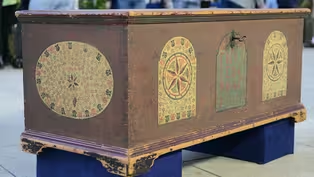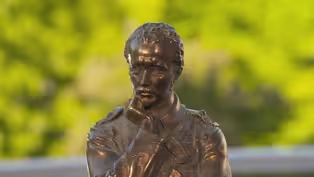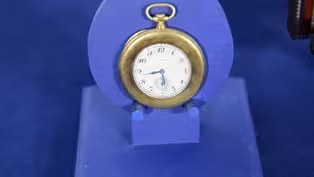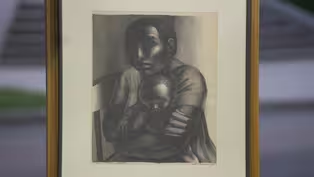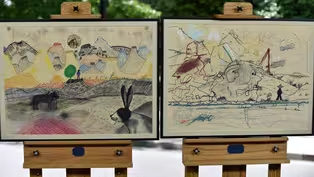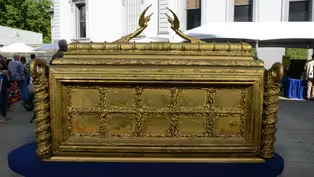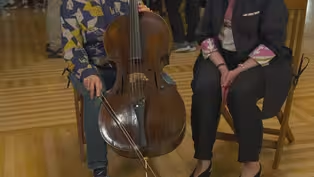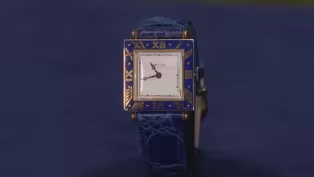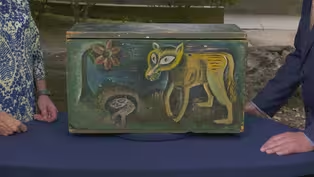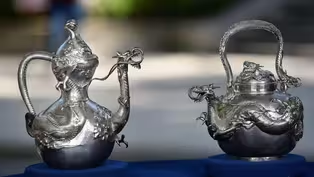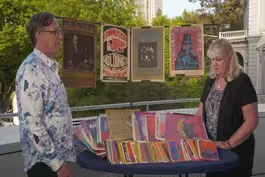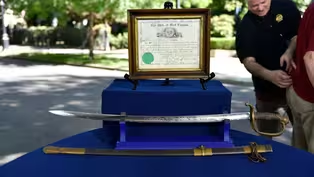
Crocker Art Museum, Hour 2
Season 24 Episode 8 | 52m 29sVideo has Closed Captions
See stunning Sacramento finds appraised at Crocker Art Museum like one worth $80K-$120K!
See stunning Sacramento finds appraised at Crocker Art Museum including a 1981 "Raiders of the Lost Ark" prototype, a 1788 Elizabeth Shoemaker sampler, and 1976 & 1977 Roy De Forest mixed-media artwork. Learn which is valued at $80,000-$120,000!
Problems playing video? | Closed Captioning Feedback
Problems playing video? | Closed Captioning Feedback
Funding for ANTIQUES ROADSHOW is provided by Ancestry and American Cruise Lines. Additional funding is provided by public television viewers.

Crocker Art Museum, Hour 2
Season 24 Episode 8 | 52m 29sVideo has Closed Captions
See stunning Sacramento finds appraised at Crocker Art Museum including a 1981 "Raiders of the Lost Ark" prototype, a 1788 Elizabeth Shoemaker sampler, and 1976 & 1977 Roy De Forest mixed-media artwork. Learn which is valued at $80,000-$120,000!
Problems playing video? | Closed Captioning Feedback
How to Watch Antiques Roadshow
Antiques Roadshow is available to stream on pbs.org and the free PBS App, available on iPhone, Apple TV, Android TV, Android smartphones, Amazon Fire TV, Amazon Fire Tablet, Roku, Samsung Smart TV, and Vizio.
Buy Now
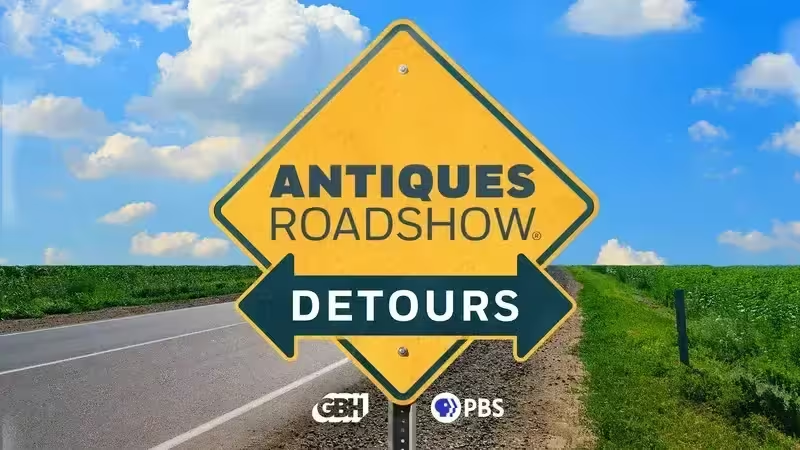
ANTIQUES ROADSHOW DETOURS
Ever wondered what happens to the treasures featured on America’s beloved ANTIQUES ROADSHOW after the cameras leave town? Host Adam Monahan tracks down the juicy afterlives of your favorite finds from PBS’s hit series.Providing Support for PBS.org
Learn Moreabout PBS online sponsorship♪ ♪ CORAL PEÑA: It's a golden opportunity when "Antiques Roadshow" visits the Crocker Art Museum in Sacramento.
APPRAISER: Do you remember it as a child?
WOMAN: Oh, yeah.
I scratched the teeth out of the wolf because it scared me.
Hot dog!
♪ ♪ PEÑA: The Crocker Art Museum, well-known for its outstanding display of California art, was the vision of philanthropic couple E.B.
and Margaret Crocker.
The Crockers purchased the property in 1868, and added on to an existing house, creating an even bigger building for their growing art collection.
After it was completed in 1873, the Crockers' gallery of art was considered to be local architect Seth Babson's crowning achievement.
Today it's listed in the National Register of Historic Places.
Fast-forward to 2010, when the 125,000-square-foot Teel Family Pavilion opened and more than tripled the museum's size.
Our dedicated appraisers are looking at thousands of objects brought to the Crocker today.
Check it out.
♪ ♪ WOMAN: It was his.
MAN: It was in here with this collection.
But the stuff is always great.
(talking in background) When it comes to Golden Age comics, anything of this vintage is going to be incredibly hard to find in a high grade.
When you look at the date, 1944, you're right at the tail end of World War II.
There's still paper drives going on.
When we grade comics, we grade them numerically on a scale of one to ten.
You're averaging about a 5.5 to a 6.0.
Oh, wow.
So it's a really good book.
In this condition, if it were to be professionally graded and preserved, conservatively at auction, you'd be in the $500 to $800 range.
Oh, my God.
APPRAISER: It's a great book-- great book.
WOMAN: Yeah, I love it.
WOMAN: These were gifts from my parents.
I was born and raised here in Sacramento.
And these pieces are by a local artist named Roy De Forest.
So when did your mother gift these to you?
They downsized about ten years ago, so I would say I came into them about eight years ago.
The first piece was acquired, the one closest to you, in about 1978.
And this one later, in the mid '80s, I think around 1984.
They purchased them from a really fun gallery that's no longer there, in Folsom, California, from a woman named Adeliza McHugh.
She followed and tried to nurture the careers of a lot of U.C.
Davis artists.
And there's a story-- I don't know if it's true-- but that her patron was Vincent Price.
What was the name of the gallery?
The gallery was the Candy Store.
Okay, the Candy Store Gallery was very well-known for holding exhibits of U.C.
Davis faculty.
What did your parents pay for them when they bought them?
They paid about $800 each.
Okay.
You brought in two examples by Roy Dean De Forest, who was born in Nebraska in 1930, but spent the bulk of his career in California, most notably at U.C.
Davis, where he taught from 1965 until 1992, and eventually passed away in 2007 in California.
The neat thing about U.C.
Davis during that period of time was that artists like Roy De Forest and Wayne Thiebaud...
Yes.
And Robert Arneson sort of all came together at the same period of time.
The stars really aligned there.
Mm.
Roy De Forest sort of coined the movement the Nut Art Movement in an interview in the 1960s, which seemed to indicate that he wasn't interested in the prevailing trends and styles.
He didn't want to be painted into a corner.
And he and his colleagues at U.C.
Davis were also loosely referred to as the Funk Art Movement, and they exhibited together as such.
De Forest moved to a farm in the state of Washington, and often his works were very whimsical, included many animals, because that's what he grew up around.
And he was pretty irreverent about academic traditions.
And he also rejected the pure abstract notion that many of his contemporaries were working in.
He liked representational figures.
And so, as you can see, we have two works here.
They would be mixed media.
Each one consists of crayon, some pastel, and some graphite.
And both of them are untitled, as most of his work was.
They were sort of loose, imaginative works that he constructed.
Each one is signed and dated.
The first, on my side, is signed here; it's kind of tough to see, and it's dated 1976.
That was right at the height of De Forest's maturity.
Mm.
The other is signed toward the top and dated 1977.
De Forest now, when you put it into the perspective of the, of the fair market today, he's what I would call a pretty hot artist.
They are in more contemporary frames.
And, actually, De Forest often was known for producing his own frames.
Mm-hmm.
Painting them, decorating them.
Do you have the original frames, or do you know what might have become of them?
We have the frames.
And the reason that we took them out of the original frames is because they were made of a wood material that was tarnishing the edges of the artwork itself.
And are they plain-seeming or are they decorated by De Forest?
They're heavily decorated.
If these are coupled back with their original frames... Mm-hmm.
I would strongly recommend it.
And there are methods that you can use so that you can prevent any deterioration or toning of the paper.
Hmm.
His work is made much more desirable when coupled with the original frames.
But as they are, a reasonable, conservative auction estimate would be $5,000 to $7,000 for each.
Wow!
That's wonderful!
My parents will be thrilled.
Some of De Forest's work in the last five or so years that are larger, more substantial, have started to crest north of $50,000 at auction.
Wow!
That's an eye-popping number.
Yeah.
WOMAN: It was my husband's grandmother's.
APPRAISER: It's unbelievable to see one this size.
And you see how these pearls are pavé set?
It's set on both sides, which is insane.
They just didn't do that.
Inside, there's a mark right here.
There's a little saber, like a sword.
Uh-huh.
It's Riker Brothers, Newark, New Jersey.
Probably around 1900.
And then you have this fabulous American chain from the same period.
At auction today, $4,000 to $6,000.
Oh, my gosh!
Yeah, it's, it's fantastic.
Wow!
It's great.
Best one I've seen in years.
WOMAN: My father told me that it was painted by his cousin, Donald Bush Cordry.
And this was given to the family probably in the '20s.
He went to the Minneapolis School of Art, and eventually met, I believe, Tony Sarg.
Oh!
And got interested in the Mexican masks.
He collected masks, but he also did puppetry and marionettes.
And his famous Sprite and the Dolly Sisters are in the Smithsonian Institution.
So he was very highly regarded.
Yes.
And very creative.
Do you remember it as a child?
Oh, yeah, yeah.
As a matter of fact, I scratched the teeth out of the wolf because it scared me.
(laughing) Well, for a kid, that makes sense.
These creatures are menacing, and yet-- and this one toothless, not quite so menacing now.
(laughs) So we're going to, we're going to turn it around, and you can, you could see that he was intent on painting every surface.
It's almost as if it was meant to be in the middle of the room and not against the wall.
Mm-hmm.
Prairie dogs, vampire bat.
At first, when I saw it, I thought, "Oh, this was done by an outsider artist that just had fun."
But, obviously, he became something very different than that.
Mm-hmm.
It's survived in really great condition.
This wonderful, bright choice of palette.
There's a great sense of humor here.
And it's scary at the same time.
It's got a lot of elements that I find very, very endearing.
So I would think, in this instance, we came up with a figure of $3,000 to $5,000, at least, for instance, if it were being estimated for auction purposes.
Mm-hmm.
But I suspect there isn't enough money in the world to buy this box.
Right.
And I think it's-- I think it's very special.
Thank you so much.
Wonderful.
Thank you.
Okay.
PEÑA: Edwin Bryant Crocker, called E.B., was an abolitionist and a lawyer who famously represented a family that fled slavery in the late 1840s.
In 1863, he was a California Supreme Court justice, but left the bench to become the legal counsel for the powerful Central Pacific Railroad, where he worked until his failing health from two strokes forced him to leave the company.
APPRAISER: You brought us this very interesting boxing photo and this pocket watch.
Mm-hmm.
But what's more intriguing is what's on the back of this pocket watch, and it says, "Presented to Jess Willard, heavyweight champion, Havana, April 6, 1915."
Jess Willard was my great-grandfather.
When his son, my grandfather, passed away just a few years ago, this artifact was found among his things, and my mother gave it to me.
What did you know about your great-grandfather?
That was he was the heavyweight champion for four years.
Mm-hmm.
That he originally beat Jack Johnson.
Right.
And then, four years later, lost to Jack Dempsey.
Now, did you ever get a chance to meet him?
When I was a very small child, and I don't remember.
What did you learn about him growing up?
Oh, well, it was just a big deal.
Right.
It was a big deal in our family.
I know he was born in, I think it's... Pottawatomie, Kansas.
He grew to six-foot-six.
Yes.
And 240 pounds, he was known as the... Pottawatomie.
Pottawatomie Giant.
Uh-huh.
But he moved to Oklahoma, and he became a cowboy.
I didn't know that!
Okay!
So the question is, how did he become a boxer?
In 1910, he was going into town on errands, and a gentleman named J.D.
Brock discovered him.
He saw he was so tall and had such a great wingspan and was so strong, that he was going to make him a boxer.
Okay.
And your great-grandfather said he decided to become a boxer because he wasn't well-educated and he thought it was a good way to make a living.
He could have been called the Pottawatomie Gentle Giant, because he was known to be a very gentle, laid-back person who didn't want to hurt anyone.
So how ironic that he became a boxer.
Mm-hmm.
His first bout was in 1911, and he lost his first bout, but then he won the next 23 of 29.
Now we're looking at, well, what was this bout in Havana that took place in April of 1915?
Well, it was a bout for heavyweight champion of the world.
Mm-hmm, mm-hmm.
And it was probably one of the most dramatic and to some, controversial, bouts ever in the history of boxing.
His opponent was named Jack Johnson, as you just mentioned.
Right, right.
And Jack Johnson was African American.
Right.
And he was really the first world-famous black athlete.
Mm-hmm.
Jack Johnson become heavyweight champion in 1908.
He had defended his championship for seven years.
He came up in what's called the Jim Crow era.
Right.
Racism was rampant.
Many black athletes were not allowed to participate in any major sports.
And yet, he was able, which I think is a tremendous feat, to become this heavyweight champion and to hold on to it.
But because of that, there was an entire faction, unfortunately, due to racism, that was trying to unseat him.
Right.
And your great-grandfather was considered one in a line of "great white hopes."
Right.
Now, why is it in Havana, of all places?
Why was it not in the United States?
There was an act passed in 1910 called the Mann Act, and he was convicted of this.
So the only place that they could fight in 1915 was Havana.
Oh, okay.
And they fought at a place called the Oriental Racetrack, which literally had just been opened.
So in those days, fights weren't 15 rounds.
They could last as long as 40 rounds.
And there actually is film that exists of this.
I have seen some of that.
I want to say it went 26 rounds?
Jack Johnson was winning most of the rounds.
But the turning point was the 20th round.
And all of a sudden, your great-grandfather started getting, you know, picking up a head of steam, and started hitting Jack Johnson more.
And in the 26th round... Oh, okay.
He hit him with a right and put him down.
And it's said that Jack Johnson tried to grab on, grab hold of Willard as he was going down, but couldn't, fell to the mat.
And your great-grandfather won heavyweight championship of the world.
Yeah.
Well, how does this watch come into play?
The friends of Havana were so thrilled-- think of the huge windfall they got from all these people coming to town and all the tourists spending money.
This was a huge event.
They gave your great-grandfather-- they gave Jess Willard and Jack Johnson both these watches.
Oh!
That's why it's dated April 6, 1915.
This was a show of their appreciation.
Okay!
The one that belonged to Willard, it's engraved "heavyweight champion," where, of course, Jack Johnson's is not.
You know, your great-grandfather, Jess Willard, went on to a really great career the next four years.
He got to defend his championship.
And then, of course, he lost in a brutal bout in 1919 to Jack Dempsey.
He lived a great long life; he lived till he was 87.
My guess is that this is probably the only award that goes along with him winning this heavyweight championship bout.
So I would put an auction estimate of $15,000... Oh, wow.
To $25,000.
Oh, wow, okay.
Now, the watch itself is 18-karat gold.
That's probably worth, without this engraving, probably about $400 to $600.
Okay.
So there's a big difference.
I'd insure it for $50,000.
Wow.
Wow.
That's very surprising.
(laughs) The boxing market over the past few years has kind of actually gone downhill.
Mm-hmm.
There's not the same interest level, except for Muhammad Ali.
I brought a painting, and I don't know much about it, other than my grandparents bought it, I believe when they were in Asia, about the time I was born.
And I looked around online, and couldn't find anything about it, so hopefully I'll learn something today.
This is called a gable mask.
It would have hung on the end of a big house, a big ceremonial house, in Papua, New Guinea.
Oh!
Oh!
And it was probably made between 1950, 1960.
And they're not made so much for ceremonial use, but, you know, people really like these huge things in their houses.
Yeah.
They'll go for $400 to $600 pretty easily.
Oh, okay.
In the decorator market.
It's a great, great piece.
WOMAN: I bought this bracelet at a gift store in a winery in Oregon House, in California.
I bought it in '93.
At the time, I was a sixth-grade teacher teaching ancient civilizations.
And, of course, ancient Egypt is a part of the curriculum.
My students did several pieces of papyrus painting, so I needed authentic artifacts for them to study.
So I saw this bracelet.
How much did you pay?
$25.
It was passed among the students for many years.
It does not scratch, so I don't understand how they did this piece of jewelry.
Well, the reason it hasn't scratched is because you've got two types of enamel.
The center, we have guilloché enamel, which is the metal that's engraved underneath.
And on top of that is some painted enamel.
And then along the rim, this is called cloisonné.
It is from the 1920s.
Oh, cool.
And I first thought it was American.
But I discovered a mark that tells me it was made in Egypt.
(gasps): Terrific!
Hot dog!
(laughs) Wonderful.
And it's on the very tiny little jump ring on the end.
Oh!
It's authentic Egyptian.
And I think... Oh, my!
On today's market...
I love it.
It's sterling silver.
The enamel is in perfect condition.
And I think, on a retail level today, it would be about $800.
(gasps): Really?
Yes.
Hogwashes, that's great.
$800?
Yes.
Wow.
PEÑA: Like many Americans of their era who came from humble beginnings and accumulated wealth, the Crockers' art education came later in life.
The couple traveled to Europe from 1869 to 1871, acquiring almost 2,000 works of art.
The majority of their paintings were German works from the 19th century.
I got it for Christmas a couple years ago, because my wife is always encouraging me to find a nicer cello.
And when I played this one, I fell in love.
And I know it's, like, maybe a couple hundred years old, and I think it's German.
And so what did you pay for it?
$7,000.
There is a label inside this cello, and we have tried very hard to determine what it says, and it's absolutely undecipherable.
But it is the original label, which is very interesting.
Okay.
And we can tell that it's the original paper on, that would have been used during this period.
So we're dating the cello to be 1770.
Okay.
And the origins to be Northern Austria.
Oh.
Not German.
Oh!
And it's modeled after the work of Stainer, who was one of the Tyrolean makers very popular at that time.
It's all original, and it's very fun to see something that's in such a pure form.
Now, it's not in great condition.
We can see that there are multiple cracks on the body of the instrument and on the ribs, and that does have an impact on value.
I think if you went back into the retail marketplace, it would be a $15,000 cello.
Wow.
And if this cello were in really perfect, pristine condition, it would be a $60,000 cello.
Wow.
So I would love to just hear it a little bit.
Could you play?
Sure.
Great-- great, great.
(playing slow piece) WOMAN: It belonged to my great-grandfather, and he immigrated from Germany to Pennsylvania.
APPRAISER: Mm-hmm.
And then moved to California.
Okay.
Moved to Nevada County, where he owned a stage line, and used to run the stages between the old gold-mining areas.
Wow.
And this was in his things, and it went to my grandfather, then my father, and now me.
So I, I don't have any clue about where it came from, who did it.
Now, what period did he own it?
He came to California... 1860s or '70s.
Okay, okay.
We were at the folk art table, and I looked over, and saw this.
And I had to contain myself, actually, because I get pretty excited about walking sticks.
Oh!
It has such incredible detail.
If we start up here with the alligator, we have this wise owl, and this, probably a blue heron.
Mm-hmm.
With the, with the fish in its mouth.
And then the squirrel.
The deer?
Mm-hmm.
With the antlers.
Mm-hmm.
Ends up down there, the hoof.
I just want to look at this side of it right here, just go down and see this, this beautiful...
It looks like a buffalo here, charging.
Mm-hmm.
And the lion, so ferocious, the tiger, a turtle.
Probably a crane?
And I love, I love this toad.
Yes, yes.
I mean, is that your favorite?
Yeah, the frog, or the toad-- it's colorful, too.
The color, right?
The greens?
I mean, this is part of what made me excited, is to see the... Not only the detail, but the way the carving's arranged, and the coloration.
Where do you think it's from?
I don't have a clue.
I originally thought it was German.
I really do think that this is an American piece.
Oh!
For two reasons.
One is that it has things like alligators.
It has a variety of beasts that you wouldn't see in a German Black Forest carved walking stick.
The wood tells us that it is an American piece.
Ah, okay.
It's called manzanita, and it's a wood indigenous to California.
And it is clearly, from the coloration and everything else-- the oxidation-- between 1875 or so and 1900.
It just has everything going for it.
It's a winner.
What do you think the worth is?
I don't have a clue.
I looked on the internet, can't find anything that is even similar.
$200, $300, I don't know.
Okay, $200, $300, right.
I would insure this... ...for $5,000.
Oh, my!
Yeah, easily.
What a pleasant surprise.
WOMAN: I acquired them at junior college when the girl would come through and give out posters.
And, um, somehow she liked me, so she always made sure I had one, yeah.
APPRAISER: And you did attend these concerts, as well.
Most of them.
So your friend who brought these posters to you, they were free posters.
Yes.
The very earliest of these posters are in the 1966 era?
I would think they'd mostly be '66, '67, maybe '68.
Mm-hmm.
Well, of these acts that we have here, we have Big Brother and the Holding Company.
Over here, we have a fan club poster for the Grateful Dead.
This is a really interesting poster.
It's got Big Brother and the Holding Company and the Merry Pranksters.
Up top, you can see the Hells Angels.
This is kind of the first band in San Francisco, the Charlatans.
Down in here, there are almost 40 posters, and there's incredible groups in here.
And then down here, we have all these beautiful handbills.
The entire collection that you have is $5,000 to $8,000 at auction.
I feel like crying, I wish I took better care of them.
(chuckles) Wow!
♪ ♪ WOMAN: My grandfather was in the U.S. Navy.
He's a World War II veteran.
You're called a polliwog before you cross the Equator, and then after you do, you're called a shellback.
And this is the certificate that you get for that.
APPRAISER: It's an eight-day clock made by Ansonia Clock Company.
They were in New York City when this clock was made.
And the clock dates about 1885.
1885, write it down.
WOMAN: I got it, I got it.
This clock, when it was originally made, sold for about $25.
Today, it would sell for a retail price of $750.
Oh, my God!
(laughs) Nice clock.
Thank you!
MAN: I brought a sword from my great-grandfather and his commissioning document from the Civil War.
Before the Civil War, he was a student at Virginia Military Institute, and when Virginia and West Virginia split, he had to resign from VMI, and he enlisted in the 14th Regiment of the West Virginia Volunteers to fight Virginia.
Two years later, he became a sergeant major of the 14th, and then a year after that, he was commissioned and became an officer, and that's when he got the sword.
West Virginia was primarily Unionist territory, and in 1861, they voted to secede from Virginia.
They don't officially get adopted as a state until 1863.
Okay.
But he joins this regiment in August of 1862.
This is a classic example of the Civil War being that battle of brother against brother and divided loyalties.
He turned against his home state, went with the western part of the state, and fought against the Confederacy.
One of the interesting things about your sword is, it's a European import.
Oh, really.
Model 1850, foot officer's sword.
It's either French or German, probably from Solingen, Prussia, if it's a German-made sword.
Okay.
But it's not maker-marked, and I can tell by the style it is not a U.S.-made sword.
As an officer, you had to buy your own equipment.
So if you didn't have a lot of money, you would often buy a less expensive imported sword.
These swords were really more a badge of office, not really a fighting weapon.
Okay.
Occasionally, they did use them as forms of direction for the men.
You can see the decorations on the blade on this side with all the U.S. patriotic motifs: the American eagle, the panoplies of arms, the shield of Columbia, all the patterns that would be appropriate to a sword intended for the U.S. military market.
Okay.
The sword retains its original scabbard.
It's a blue-steel scabbard with brass mounts, two suspension rings that allowed you to attach it to the hangers that attached to the sword belt.
As an imported foot officer's sword in this condition, with the scabbard, if we had no I.D., didn't know whose sword it was, what it was-- who had used it, we would have a value on this sword at auction of probably between $800 and maybe $1,200.
Wow, okay.
Somewhere in that range.
However, we've got his commission.
The sword's been in the family all these years.
So all of a sudden, we have an I.D.
'd sword to a regiment that did some interesting service in the Shenandoah Valley toward the end of the war, with Sheridan.
They were instrumental in helping starve the Confederacy by destroying the Confederacy's bread basket of the Shenandoah Valley.
Okay.
So here, they've got some interesting service history.
We know exactly who the sword belonged to.
And as such, I think we've got a sword here that is probably valued at auction at more like $2,500 to $3,000.
Come on.
Because we've got some good history about it.
Wow.
If I was going to insure these items, I would probably insure it in the $3,000 to $5,000 range.
Wow, thank you.
WOMAN: This is my grandfather's watch.
This is my grandfather.
He was the chief engineer of the Golden Gate Bridge in 1940, and the resident engineer who built the Golden Gate Bridge in 1933.
It's a Longines watch, made probably in the very late 1930s, 1940s.
And if you look on the back of it, it's engraved to your grandfather.
And it was given to him by the employees of the Golden Gate Bridge on March 15, 1941.
As a Longines watch-- and it's rose-gold-filled-- it's probably a watch that's worth about $150 to $200.
Mmm.
But because it was your grandfather's watch, and with this engraving and all the provenance, I would estimate the value of this watch to be in the range of $2,000 to $2,500 retail.
Wow.
That's wonderful.
Thank you.
WOMAN: I brought in a cat gumball lottery machine that was given to me by my mother a few years ago, but it actually belonged to my father.
He acquired it in the late '50s from a friend.
He traded something for it.
What did your father trade for it when he got it?
That I don't know.
Well, it's a very interesting piece.
It's a very rare piece.
It is called the Lukat.
Up until a few years ago, there was only believed to be about a half a dozen of these known.
Really?
Now, a book came out talking about them.
There's about two dozen known, but that's still a very rare item.
This one is a nickel machine.
They also make it as a dime machine.
At the time the book came out, there was believed to be only one nickel machine in existence.
So presumably, you may only have the second.
Wow.
Can you show me how it works?
So there's a coin slot here in its ear.
You just put the nickel in and you pull its tail, and then... You push that-- oh!
And I got lucky, I got two gum balls.
And we pull the ticket out.
Commercially, this piece was a disaster.
Mechanically, it's very complex.
And oftentimes, it would break, jam up, and rather than be burdened with taking it completely apart to fix it, it got discarded.
This was produced roughly in the 1940s-1950s.
As far as where it was produced, reportedly, it was produced in San Francisco.
It's also believed that they could be from the Midwest.
Could you tell me about where you put the gumballs in the machine?
So the gumballs go in right back here.
Okay.
And then there's a key, a skeleton key that opens the drawer.
Sure.
To remove the coins.
Okay.
Well, it's a very fascinating piece, very attractive, very desirable.
It has a cross-collectivity.
It's a figural cat, which are very popular.
It's a gumball machine, trade stimulator, and it's also a lottery machine.
It dispenses the ticket.
Have you ever had it appraised before?
I had one gentleman offer me up to $5,000 for it.
It could possibly bring about triple that.
So an auction estimate on this piece would be roughly $10,000 to $15,000.
Wow.
And it could bring more.
Well, I'm glad I didn't take his offer, then.
I think so.
I used to be afraid of it when I was a little girl, till I found out there was gum in it.
PEÑA: Luis Jimenez's "Progress II," created in 1974, is one of the artist's earliest monumental sculptures made of fiberglass.
Jimenez's work often explored cultural and natural elements of the American Southwest.
The positioning of the cow and the vaquero on horseback at dramatic angles creates a dynamic tension, capturing the relationship between predator and prey in the Southwestern desert.
WOMAN: I brought in part of a tea set, which I inherited.
My mother passed away in 2006, so I've had them for the last 12 years.
My father purchased it at auction in San Francisco around 1961 or '62.
The one story that I gathered from speaking with my sister is that my, my dad picked this up, brought it home, and my mom was furious with him for spending the money on something non-essential.
Did your mom ever grow to like this over time?
Oh, yeah.
We think it's pretty special.
There are marks on the bottom, but they're either Chinese or Japanese.
They are Japanese, not Chinese.
Oh!
And the mark nearest me is the Japanese mark that indicates that it's sterling silver.
Then the mark next to that is essentially "made by," and then the two further marks are the mark of the maker Konoike.
We have a tea and a coffee pot.
That's amazing.
The teapot is near me.
They are fully decorated in the round with these dragons, whose very elongated whiskers wrap themselves back around their swirling tails and work their way into the handle.
Over here, you'll see that the dragon tail wraps all the way up, and then the foot, even, is the claw that is holding this little shell that's the knob.
And then the body of each is decorated in this hammered design.
They're... it's fantastically decorated.
They're beautiful.
Made in Japan in the Meiji period, which is 1868 to 1912.
Oh, my God.
And I would peg these to right around 1900.
Obviously made by a very talented maker.
And so you said your father paid?
Between $300 and $700.
And that was for how many pieces?
There's roughly about 18 pieces.
This tea and coffee service is quite rare.
They're in really good condition.
The two objects you've brought here today, I would insure them, together, for $30,000.
Okay.
Wow.
(laughing) That's a lot, compared... considering what else is still... unreviewed.
(chuckles) Right.
All right.
I better get them insured.
♪ ♪ APPRAISER: The detail is amazing.
The fur, its incising is amazing, and that had, that couldn't be done in a mold.
That would have had to be done by hand.
WOMAN: By hand.
There's these colorless incised numbers.
And that's a very German thing.
I am fairly certain that this is late- 19th-century German, but I don't have a clue who made it.
So the value is going to be based on just the decorative appeal and the quality.
A lot of people get this wrong when they're doing posters.
They see these numbers down in here, in the corner.
MAN: Yeah.
And it looks a lot like when you have a print, and we call it "limitation numbers."
That's not actually the case.
This means that this was the 1,026th poster that the National Screen Service approved for the promotional campaign in 1946.
Oh, okay.
One of the things that drives prices on posters is, who's in it and what is the film?
Joan Bennett, at one time, was a much bigger star.
She's not a household name anymore.
And "The Woman on the Beach," this is not a movie that's in heavy rotation.
I hear you.
(all laughing) WOMAN: I found this at a thrift store.
APPRAISER: And you go there often?
I do.
On my lunchtime, I typically go looking for treasure just to wind down.
But this appealed to you one day at lunch.
It did.
I, I just couldn't leave it behind.
I think he's a hottie.
(laughs) I just think he's adorable, and he's gorgeous, and he looks great on any shelf.
He is a handsome devil.
(laughs) It's a very interesting sculpture.
It's by one of the leading English artists of the late 19th century.
His name is Hamo Thornycroft.
And it's signed very clearly, and it's dated 1888.
And this is a depiction of a general, General Gordon.
And General Gordon was one of the premier Victorian soldiers of that period, from the 1850s to the 1880s.
He was incredibly famous in England at the time.
And here he's depicted, though, not in a militaristic way.
He's sort of turned inward.
He's more pensive.
He's more thoughtful.
He was so important that they commissioned a ten-foot version of this for Trafalgar Square in London, and another ten-foot version for Melbourne, Australia.
It was in Trafalgar Square from the late 19th century till 1943.
It was taken down during the war, and it was eventually moved, and now it's on the Victoria Embankment.
Thornycroft was an important sculptor of the period.
He was a leader of a movement called the New Sculpture.
It was sort of a movement away from traditional academic sculpture into more modern sculpture.
It was made in an edition.
And on the back, the gallery that produced the edition inscribed their name on it.
So when you showed it to me, it had these two little dots here.
At some point in its life, somebody made it into a table lamp.
It doesn't really affect the value very much because it can be easily restored.
Oh, okay.
What did you pay for it?
$26.95.
I think a retail price on this would probably be in the $4,000 to $5,000 range.
Wow.
(laughs) I guess he was worth it.
(laughs) We got this one up at a flea market, basically.
It was $90.
It was shoved in the back of a cabinet, um, and I saw it kind of peeking out, and I loved it.
And so this one, I picked up online.
I saw it, and it was, like, $80.
And I said, "Sure, why not?"
It's my great-great-great- grandfather's.
I don't really know a lot about it.
I know that he was a volunteer fireman.
This is a great example of an early firefighter's helmet.
It's made of leather.
It's actually got some embossing on the leather, and the brass eagle here, and then this wonderful crest, which tells us he was in the...
He was a veteran of the Volunteer Association.
Mm-hmm.
And back then, there weren't, like, fire departments like we know today, like, public fire departments.
They were mostly volunteers.
In today's market, if you had to buy that in a retail shop from a collector, it would be something like $250 to $300.
Wow.
MAN: I know that it came into our family when my mother's mother passed away.
I took an interest in it 30 years back and was looking at these words that were on the back of the sampler that described the sampler having been done by this woman Elizabeth, married to Daniel Stroud of Stroudsburg.
Looked up possible places on a map, and decided this must be Pennsylvania.
This was my fourth-great- grandmother did the sampler, and my fourth-great-grandfather is Daniel Stroud of Stroudsburg, Pennsylvania.
The father, Jacob Stroud... Jacob.
had apparently given the name to the town.
It's beautiful, and it's a remarkable survivor, because, as you have indicated, it was worked by Elizabeth Shoemaker, her work in 1788.
So that's a really early date.
She probably emigrated to the United States from Germany.
She met Daniel Stroud.
And they were married.
In fact, they were married about four years after the sampler was worked.
She was 14 when this was worked.
And she was married at 18.
These were things that were part of a young woman's education.
It's worked in silk threads on a linen ground.
And these colors have remained remarkably vibrant.
They're vegetable dyes that were used to dye the silk used in the embroidery.
Mm-hmm.
And they're fugitive.
We feel that the insurance or replacement value on this piece would be somewhere in the vicinity of $25,000.
(sputtering) (laughing): Really?
That's, that's amazing to me.
Right.
It's a winner.
I...
I'm... speechless.
(laughs) I...
I thought it had a couple of thousand dollars of value.
Yeah.
♪ ♪ PEÑA: Margaret Crocker gave the gallery and her cherished art collection to the city of Sacramento in 1885.
This was a big deal for the city, as no other public art museum existed in California at that time.
The citizens of Sacramento celebrated the gift in grand style.
The local newspaper sang Mrs. Crocker's praises.
And a special flower festival was held in her honor that year that included inspirational speeches and elaborate floral displays.
APPRAISER: Tell us what you brought today.
WOMAN: A Dover chest.
I fell in love with it when I found it at the thrift store.
How long ago was that?
About two years ago.
Really?
I was at the thrift store, because it's right down the street.
And I go there all the time, and I happened to be walking out and one of the employees was bringing it out, and I seen it, and I'm, like, "I have to have it."
When I was looking inside of it I found a little piece of paper that said it was from Philadelphia.
That is an interesting story.
It's not quite from Philadelphia, but it is what we call a paint-decorated blanket chest or dower chest.
And it was likely made in either Dauphin County, Lebanon County, or Montgomery County, Pennsylvania.
Okay.
And one of the ways we can tell that is by this sort of tripartite paint decoration.
What's really interesting is the center panel here.
I did some research and looked up "fede."
Uh-huh.
And that means sort of commitment or marriage.
Okay.
So that's why we get the name dower chest.
And it's dated here 1785.
If we open the chest up, you've got these wonderful strap hinges.
These are original hinges from the 18th century.
Oh, wow.
I love how the edges are finished with this nice little chamfered edge.
The wood that it was painted on is a combination of poplar and pine.
It's got a nice well in here, and this is what we call a till.
And it was a place to store valuables.
The Pennsylvanian cabinet makers were famous for putting hidden spots, so you could hide your valuables.
If you were a thief, looks like you've got only, only this area.
Right.
Where you would keep things.
But if I raise this, there's these hidden drawers.
It took me a couple of days to find those.
(laughing) Did it?
Yes, it did.
Well, what I love about it, you can see, there's 18th- and early- 19th-century script which says, "Samuel Vanderlin."
Okay.
And if I turn it over...
I even have something that says "John H.
Lick."
And then it says, "Fredericksburg, Lebanon County, P.A.," and it's dated 1814.
So these are likely owners that it was passed down to.
What I love about this... (drawer clattering) ...is the painted surface.
And this is what we call fancy decorated.
Okay.
And it was basically to elevate the status of this chest.
And I just love, if you look on these dovetails, there's these wonderful tulips, which were all symbols of the Pennsylvania Dutch, Pennsylvania German immigrants that brought this tradition.
Now, the top is pretty worn, and we expect that.
And in terms of condition, it's pretty good.
Yes.
I'm dying to know, what did you have to pay for this?
I'm not exactly sure, but it was either $20 or $25.
Because the gentleman that was taking it out front said that it gave him the heebie-jeebies.
What?!
Yes.
On the inside was a wedding picture of a bride.
Okay.
And...
I threw it away.
What?!
Yeah, I don't...
Gave you the heebie-jeebies, too?
No, actually it didn't.
But I figured if it gave him the heebie... maybe, you know I shouldn't...
So I tossed it.
If this were to come to auction today, I would conservatively place an estimate of $3,000 to $5,000 on it.
Wow!
So that's quite a find.
Wow!
From a $20, $25 investment.
(laughs) Not bad, right?
Not bad, not bad.
APPRAISER: The value of these lies not just in the photographs, but also in the albums themselves.
WOMAN: Mm-hmm.
Having the photographs, albums that have this beautiful burnt velvet detail, and then this star with an inset photograph.
Uh-huh.
It's something that you really don't see very often.
Jo Mora is such a popular artist, and this is sort of exactly what he is most famous for, which are these poster maps with these great little vignettes.
It's one of these things that the price is going up and up, because there's been a resurgence of interest in what we call poster maps.
And currently, I would say an auction estimate for this would be $2,000 to $3,000.
$2,000?
You're kidding!
Oh, my God, that's amazing.
Oh, my gosh!
I'm so excited.
It's great.
I was in college when I bought it in 1956.
I'm from Chicago.
And I believe the artist was in town at the time.
He was, yeah.
John Wilson was in Chicago in 1956.
He's a wonderful artist, and this is just a fantastic example of his masterful printmaking.
He is from Boston, born in 1922.
Studied at the MFA in Boston, had prestigious Hay Whitney Scholarship, studied with Fernand Léger in Paris.
Uh-huh.
And in the '50s, at the time this was made, he was studying in Mexico with printmakers at the Taller Gráfica Popular.
He did many images of African-American families, were very important to him as an African-American artist.
So this is a wonderful example, and he really beautifully depicts a mother and child.
This is related to a painting he did where the mother is hiding from an attack from the Ku Klux Klan, they could see out the window.
Oh.
It's a terrible image, but he picked really the most poignant part of the picture, this intimacy, this, this moment of a mother protecting her child for this beautiful lithograph.
"Mother and Child" is an edition of 54.
You can see how it printed in 1956.
He actually did two versions of this print-- one in 1952 and one in 1956.
And for some reason, the 1956 version that you have is much scarcer.
Really?
This print, at auction, sells between $7,000 and $10,000.
Well, I'm not selling it.
(both laughing) Well, this is, uh, the Ark of the Covenant that was used as a prototype in "Raiders of the Lost Ark."
My father worked on the film, and we've had it in our apartment in San Francisco when I was growing up, and now it's been passed on to me.
What did you think growing up with this in your apartment?
Oh, I thought it was neat.
(chuckles) I got to tell my friends that I had the Ark of the Covenant at home.
It was a lot of fun.
You ever hide in it?
No.
Uh, we kept, we kept blankets inside of it.
You kept blankets inside?
When did you first see "Raiders"?
I saw "Raiders" when I was a little kid.
Around six or seven.
My father worked, uh, at Industrial Light and Magic.
Mm-hmm.
In, uh, the '80s.
Mm-hmm.
He worked on "Star Wars," "Raiders."
"Star Trek."
I knew George Lucas.
He was wonderful.
Industrial Light and Magic was the special effects house.
Right.
Founded by George Lucas to do all the special effects and visual effects for "Star Wars."
And later on, worked on so many amazing projects, like "Raiders of the Lost Ark," um, "E.T."
It is now known as one of the most storied special effects houses.
And what part did your father play in this particular prop?
Uh, my father is a pyrotechnician.
Mm-hmm.
Was, and a stage tech.
His job was to load it with pyro... Mm-hmm.
And, uh, get it ready to shoot.
"Raiders of the Lost Ark," released in 1981, was the first collaboration between George Lucas and Steven Spielberg.
And it is one of the most iconic movies of the late 20th century.
It's what inspired me to get into antiques, because he made antiques sexy and cool.
And the Ark of the Covenant was the main object of desire, the MacGuffin, and it spawned one of the most successful movie franchises of all time.
Harrison Ford was wonderful as Indy.
And the scene of them in the Well of the Souls lifting the Ark out is just wonderful.
This particular Ark of the Covenant looks somewhat different than the version we saw onscreen.
Do you know why that is?
I know that this was a prototype used to size the, the pyro.
I know that the Ark that they used is significantly smaller.
Mm-hmm.
The details are different, as you know.
Yeah.
But this is one of the prototypes, maybe the first prototype, for pyro.
And that's the best part about it.
So the Ark of the Covenant was designed by Ralph McQuarrie.
He was a concept artist for "Raiders of the Lost Ark."
And he was inspired by the artist James Tissot, and his designs for the Ark, he did several drawings of it.
And this has every indication that it's just a thrown-together movie prop.
You've got a hot-melt glue gun doing all the fancy designs.
All this trim here is made from picture frames.
(chuckles): Right.
And my favorite part is, these tops here are made from trophies.
(chuckling): Right.
Kind of sloppy, put together.
Now, that original prop is somewhere in the Lucasfilm archives at Skywalker Ranch.
People who want to replicate props have scoured every scene, copy all the little details on it.
This is the closest anybody in the private market can get to owning the Ark of the Covenant from the "Raiders of the Lost Ark."
This is so inspiring and so wonderful.
I'm so excited about it.
And we estimate at auction a very conservative value of $80,000 to $120,000.
Wow.
Wow.
And not bad for hot glue and spray paint.
Absolutely.
(laughs) And, realistically, I can see it getting into quarter-million-dollar range.
It's beautiful.
PEÑA: You're watching "Antiques Roadshow" PEÑA: And now, it's time for the "Roadshow" Feedback Booth.
We're here with my mom's number-one Barbie that she gave to me, and we loved her so much that we loved her head right off.
So she's not worth nearly as much as she could be.
I've been watching "Antiques Roadshow" for years.
And I always wondered if I would have the a-ha moment, and I did.
It's $15,000 to $18,000.
I bought this pistol in 1975 in Reno from a, from a crook for $400.
And I find out that it's an engraved Smith & Wesson that's probably worth between $2,000 and $3,500, which is not a bad deal.
We came today to bring our Japanese chopsticks that turn out to be Chinese.
They're silver and worth about $300.
And our big winner is this World War II nose art, um, scrapbook that our grandmother made that was appraised at about $6,000 to $8,000.
I brought these opera glasses thinking that they were worth something, but they just couldn't see the value.
I got it when I was going to school in London, and I bought it for ten pounds, and, actually, it was made in Japan.
And it's made of silver and copper, and it's only worth ten pounds.
Ten pounds!
(groans) Thanks, "Antiques Roadshow."
Thanks.
PEÑA: Thanks for watching.
See you next time on "Antiques Roadshow."
Appraisal: 1785 Painted Pennsylvania Dower Chest
Video has Closed Captions
Clip: S24 Ep8 | 3m 36s | Appraisal: 1785 Painted Pennsylvania Dower Chest (3m 36s)
Appraisal: 1788 Elizabeth Shoemaker Needlework Sampler
Video has Closed Captions
Clip: S24 Ep8 | 2m 26s | Appraisal: 1788 Elizabeth Shoemaker Needlework Sampler (2m 26s)
Appraisal: 1888 Hamo Thornycroft Bronze of General Gordon
Video has Closed Captions
Clip: S24 Ep8 | 2m 12s | Appraisal: 1888 Hamo Thornycroft Bronze of General Gordon (2m 12s)
Appraisal: 1915 Jess Willard Heavyweight Champion Watch
Video has Closed Captions
Clip: S24 Ep8 | 5m 34s | Appraisal: 1915 Jess Willard Heavyweight Champion Watch (5m 34s)
Appraisal: 1956 John Wilson "Mother and Child" Lithograph
Video has Closed Captions
Clip: S24 Ep8 | 1m 44s | Appraisal: 1956 John Wilson "Mother and Child" Lithograph (1m 44s)
Appraisal: 1977 & 1976 Roy De Forest Mixed-media Artwork
Video has Closed Captions
Clip: S24 Ep8 | 4m 30s | Appraisal: 1877 & 1976 Roy De Forest Mixed-media Artwork (4m 30s)
Appraisal: 1981 "Raiders of the Lost Ark" Prototype
Video has Closed Captions
Clip: S24 Ep8 | 3m 51s | Appraisal: 1981 "Raiders of the Lost Ark" Prototype (3m 51s)
Appraisal: Austrian Cello, ca. 1770
Video has Closed Captions
Clip: S24 Ep8 | 1m 49s | Appraisal: Austrian Cello, ca. 1770 (1m 49s)
Appraisal: Cartier Enamel Men's Watch, ca. 1925
Video has Closed Captions
Clip: S24 Ep8 | 1m 4s | Appraisal: Cartier Enamel Men's Watch, ca. 1925 (1m 4s)
Appraisal: Donald Bush Cordry Painted Box, ca. 1930
Video has Closed Captions
Clip: S24 Ep8 | 2m 6s | Appraisal: Donald Bush Cordry Painted Box, ca. 1930 (2m 6s)
Appraisal: Egyptian Revival Enamel Bracelet, ca. 1920
Video has Closed Captions
Clip: S24 Ep8 | 1m 43s | Appraisal: Egyptian Revival Enamel Bracelet, ca. 1920 (1m 43s)
Appraisal: Japanese Silver Coffee Pot & Teapot, ca. 1900
Video has Closed Captions
Clip: S24 Ep8 | 2m 42s | Appraisal: Konoike Silver Coffee & Tea Pots, ca. 1900 (2m 42s)
Appraisal: Rock Poster & Handbill Collection, ca. 1967
Video has Closed Captions
Clip: S24 Ep8 | 1m 11s | Appraisal: Rock Poster & Handbill Collection, ca. 1967 (1m 11s)
Appraisal: Union Foot Officer Commission & Sword
Video has Closed Captions
Clip: S24 Ep8 | 3m 12s | Appraisal: Union Foot Officer Commission & Sword (3m 12s)
Providing Support for PBS.org
Learn Moreabout PBS online sponsorship
- Home and How To

Hit the road in a classic car for a tour through Great Britain with two antiques experts.













Support for PBS provided by:
Funding for ANTIQUES ROADSHOW is provided by Ancestry and American Cruise Lines. Additional funding is provided by public television viewers.


